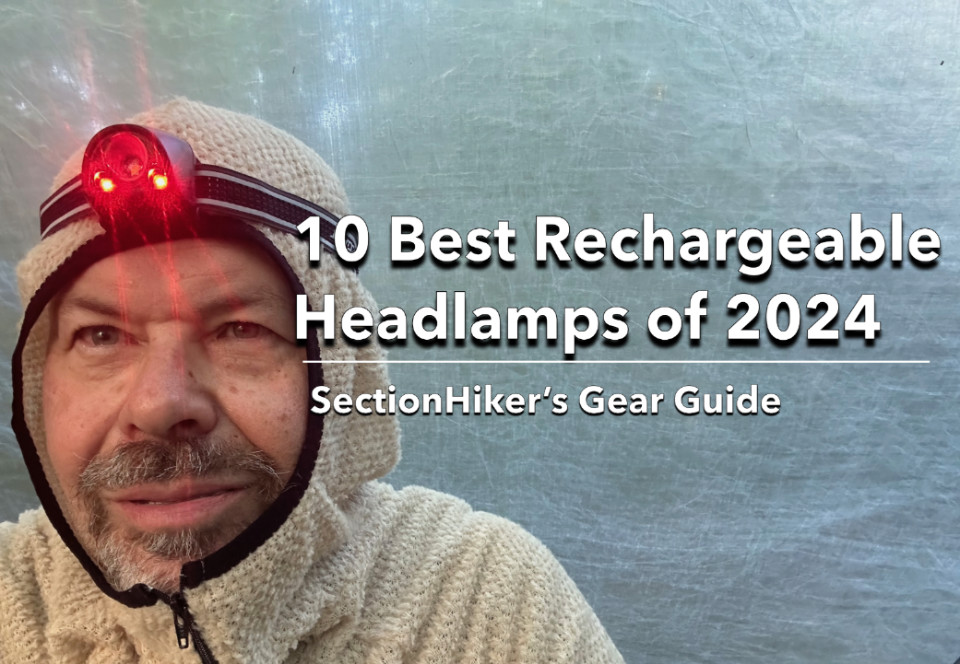
A headlamp is one of the most important 10 essentials for backpacking, hiking, fastpacking, trail running, climbing, and any other kind of outdoor adventure sport. Using your smartphone as a flashlight doesn’t cut it. But the days of carrying extra AA and AAA battery-powered headlamps are history. USB rechargeable headlamps have become ubiquitous and are very convenient because they can be recharged using the battery packs that most backpackers carry. Dual-power headlamps, ones that can be powered by a rechargeable battery or AA/AAA batteries, are handy if a “wall recharge” is not available.
| Make / Model | Lumens | Weight |
|---|---|---|
| Petzl Actik Core | 600 | 3.1 oz |
| Coast Fl1R Micro Headlamp | 300 | 1.7 oz |
| Black Diamond SPOT-R Headlamp | 325 | 2.6 oz |
| Nitecore NU 33 | 700 | 5.3 oz |
| Fenix HM50R | 700 | 2.75 oz |
| Black Diamond Astro 300-R | 300 | 2.65 oz |
| Biolite 800 Pro | 800 | 5.1 oz |
| Nitecore NU 25 UL | 400 | 1.59 oz |
| LEDlenser MH10 | 600 | 5.6 oz |
| Petzl Bindi Ultralight | 200 | 1.2 oz |
Here are our top 10 picks for the best rechargeable headlamps for backpacking and hiking. While there are some familiar company names listed below, the companies that used to dominate the headlamp market have been eclipsed by smaller more innovative companies offering equivalent and higher-functioning products. You simply don’t have to pay an arm and a leg to get a great headlamp anymore. Be sure to check out our advice below about what to look for when buying a rechargeable headlamp for backpacking, hiking, and trail running or climbing.
1. Petzl Actik Core Rechargeable Headlamp
| Shop at REI | Shop at Amazon |
2. Coast FL1R Micro Headlamp
3. Black Diamond SPOT-R Headlamp
| Shop at REI | Shop at Amazon |
4. Nitecore NU33 Rechargeable Headlamp
| Shop at Nitecore | Shop at Amazon |
5. Black Diamond Astro 300-R
Black Diamond is not known for making headlamps with trivial (easy-to-remember) controls, but the new rechargeable Astro 300-R breaks the mold. This single-lens single-switch headlamp has a white lite and three brightness levels: high, medium, and low with full strength, dimming, and strobe modes. It’s powered by a 1500 mAh Lithium-ion rechargeable battery that recharges with a micro-US charge port and has an IPX4 rating stormproof to withstand rain and sleet from any angle. This headlamp also has a digital lockout to prevent accidental activation. The headlamp has an average run time on high (300 lumens) for 6 hours and on low (6 lumens) for 140 hours. A dual-power model (the Astro) is also available that includes three AAA batteries and is compatible with a rechargeable BD 1500 Li-ion battery and charger (purchased separately) for maximum flexibility.
| Shop at REI | Shop at Amazon |
6. Fenix HM 50R V2 LED Rechargeable Headlamp
| Shop at REI | Shop at Amazon |
7. Biolite Headlamp 800 Pro
| Shop at REI | Shop at Amazon |
8. Nitecore NU25 UL
| Shop at Nitecore | Shop at Amazon |
9. LEDLenser MH10 Rechargeable Headlamp
| Shop at REI | Shop at Amazon |
10. Petzl Bindi Ultralight Headlamp
| Shop at Backcountry | Shop at Amazon |
How to Choose a Rechargeable Headlamp
Here are the most important features and considerations to evaluate when comparing different rechargeable headlamps.
Battery Capacity
Check the capacity of the headlamps you’re interested in to see how much power, measured in mAh, they can hold. If you plan on using a headlamp on a multi-day trip, it’s useful to bring one with a large battery capacity so you don’t have to recharge it from a portable power pack. Smaller-capacity batteries are fine for short runs, but you will also have to recharge them more frequently, which can be a hassle if you use them a lot.
Dual Power Headlamps
Most rechargeable headlamps bundle in a cold-resistant lithium-ion battery, although there are also dual-power headlamps that can also be powered by old-school alkaline or lithium-ion batteries. If you already carry a USB-enabled power pack to charge your other electronic devices, then the latter is probably unnecessary, although it might be useful if your power pack runs out of juice and you can’t recharge it. This isn’t a priority for me, but some people prefer having the ability to switch to regular batteries as a contingency.
Headlamp Headbands
All of the headlamps listed above have battery packs that are integrated with their light sources, so a single headband strap is all that is needed to wear them. Multi-strap headlamp headbands are only necessary for very heavy headlamps or ones with remote battery packs that are carried separately from the light source and linked by an external wire.
Headlamp Tilt
If you plan to trail run or hike at night, it’s important to get a headlamp that tilts in its strap bracket so you can direct the spot or floodlight onto the ground and out front, ahead of you.
Lumens/Light Output
The latest generation of LED lights available in headlamps are very powerful and the lumen outputs often exceed what’s required for nighttime use in camp or even for nighttime running. Anything headlamp with 150 lumens or more should be sufficient for general-purpose backpacking and hiking. When purchasing a headlamp, the maximum light output is much less important than the length of time the headlamp can burn on low power, since that’s the setting you’ll use most often in camp or in your tent.
Red Light Mode
Headlamps with a red light mode are good for preserving your night vision if you want to read in your tent or star gaze. They also help you avoid blinding your companions in camp or around the campfire. The red light mode also uses far less energy than white light modes and is a good way to conserve your battery power between charges.
Headlamp Weight
While gear weight is important, it’s often less important than a headlamp’s features, efficiency, or battery life. For example, if you need to carry a heavier power pack to recharge a lighter weight headlamp more frequently, you probably haven’t saved as much weight overall as you might like. Focus on your needs, if you know them, and let that guide your decision as to which headlamp you select.
On-Off Lock
Headlamps with manual or digital on-off locks are useful to prevent the accidental activation of a headlamp when it’s packed. I won’t buy a headlamp without one, but that’s just my personal preference.
Battery Indicator
Some sort of battery indicator is useful on a rechargeable headlamp so you know when to recharge the battery and when it’s finished recharging. Without it, you’re more likely to try to use a headlamp that is out of power when you need it.
Check Out All of SectionHiker's Gear Guides!
- 10 Best Hiking Shoes and Trail Runners
- 10 Best 2-Person Backpacking Tents
- 10 Best 1-Person Backpacking Tents
- 10 Best Backpacking Stoves
- 10 Best Backpacking Water Filters
- 10 Best Lightweight Backpacks
- 10 Best Ultralight Backpacks
- 10 Best Backpacking Sleeping Bags
- 10 Best Ultralight Backpacking Quilts
- 10 Best Lightweight Backpacking Chairs
- 10 Best Backpacking Sleeping Pads
- 10 Best Backpacking Rain Jackets
- 10 Best Hiking Daypacks
- 10 Best Hiking Pants
- 10 Best Trekking Poles
 SectionHiker.com Backpacking Gear Reviews and FAQs
SectionHiker.com Backpacking Gear Reviews and FAQs 



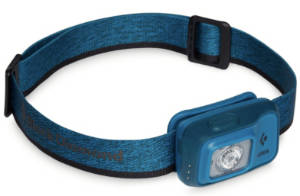

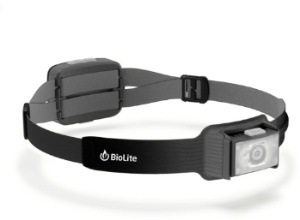
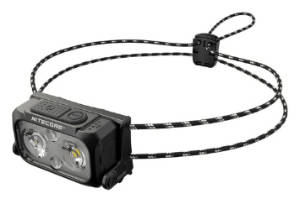

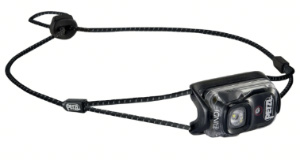
Absolutely love the Petzl Actik Core but honestly one of my favorite features is the glow in the dark feature that allows me to find the bleeping thing in the dark.
For years I have used Black Diamond but the last two headlamps I owned the lens cracked after a few years. Not sure what is going on but whatever.
One of the features I appreciate on the NU25 is the red light mode. It has two brightness levels. I am able to read at the brighter level and find its much more useful than the lower level red light mode. Do you know if the other headlamps red light mode are equivalent to the brighter red light mode on the NU25?